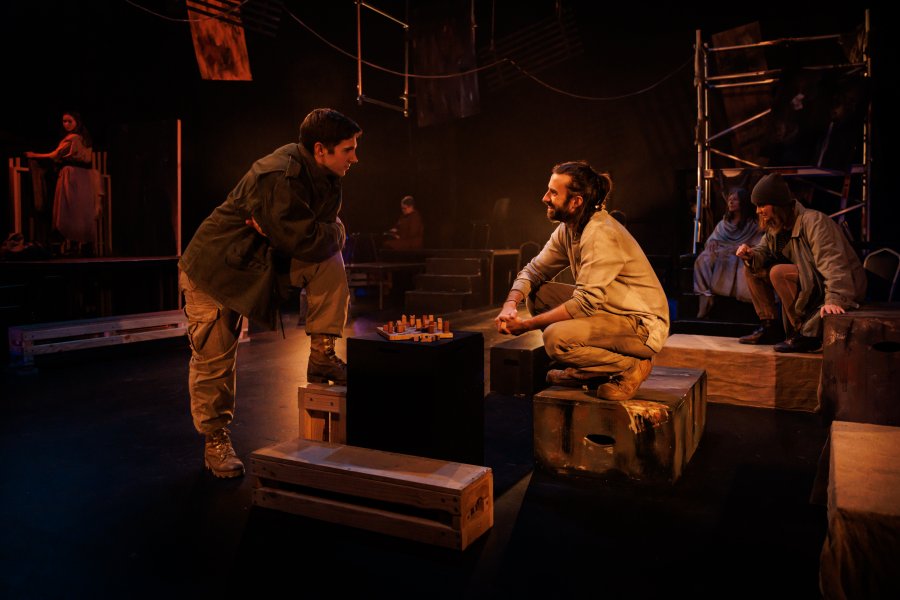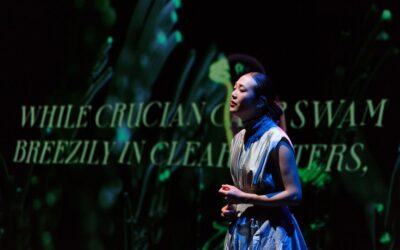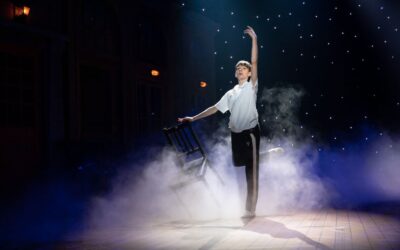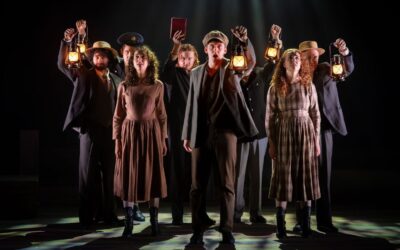By Cedar Brown
Entering Prophet’s play space, I was struck by the visually exciting design – suggestions of protest, war, and destitution suspended around the audience; the characters, wrapped in their own realities, occupying scaffolding, stages, and platforms of different levels. We were allowed to take it in for a few moments. And then someone in the crowd began to speak.
Prophet began as a somewhat didactic critique of political impotence in the face of ecological and sociopolitical collapse. ‘Didactic’ is often used in our current artistic paradigm to mean ‘bad’, but I found myself reflecting on the responsibility of art in times of sociopolitical, economic, and environmental crises to challenge an audience to action. I found myself thinking that perhaps didacticism is politically important – even necessary. To this end though, I would have liked to see the play deal with the globally unequal distribution of who will suffer most in climate disasters. And to tackle war and colonialism in more than a vague and a-historical way.
However, the play soon unravelled into a complicated psychological drama. The characters’ experiences were layered on top of each other, challenging the audience to interpret what was real and what wasn’t. Religion, family, and the psyche echoed in a complicated dance through the different monologues and interactions. J. David Franzke’s sound design was beautifully in conversation with the action of the piece, crafting and manipulating tension and emotion. As a lover of psychological thriller movies, I appreciate work that leaves the audience with questions, free to construct their own interpretations. But in a context where I struggled to see and to stay with what was happening, this lost a lot of its power for me. The costume design – a mix of Victorian farmer and modern streetwear – didn’t help much in this regard.
Prophet centres on the male ego. It very much appears as a masculine disaster narrative, where the central male characters (played by Gabriel Partington and Scott Middleton) are positioned as having the potential to make a difference. Dennis Coard’s performance as the father was also key in tethering the play to reality. It was disappointing to not see more complicated female characters from playwright Jodi Gallagher. Tropes of the wife (played by Mia Landgren) whose only existence was wrapped up in waiting for her husband and the mother (played by Carole Patullo) as amorphous maternal presence were disheartening. This said, the performance of Helen Hopkins as politician was striking in its power. And while the mentally ill homeless woman (played by Carolyn Bock) felt secondary throughout, Gallagher humanised the ‘mad woman’ stereotype in monologues portraying the systemic disadvantages experienced by those labelled mentally ill.
Central to my experience of the performance was the immersive, promenade style. In the early parts of the play, we were spoken to as a crowd, positioned with the characters as angry and scared by the failure of the politicians to meaningfully address global warming. However, the connection present in this initial involvement quickly faded. One of the challenges of immersive works is making each audience member feel like their experience of the play is a special one – nobody likes to miss out. However, in Prophet, the design was such that the tall people standing at the front of the action got to see what was going on, but for those of us at the back including those needing to stay seated for accessibility reasons, we weren’t able to really see a lot of the main action that occurred. When going into an immersive work, I assume that the immersiveness is in some way going to be key to the way that the audience engages with the performance – that the moving and standing around is going to mean something, and that the creative team have designed the experience with this in mind. But in this case, I felt as if the audience was often forgotten. The relatively tight space made it hard to follow the performers, seats were behind and below the standing area, and the single point of action and focus meant that there was nothing to engage with if you weren’t front and centre of the action – I spent most of the play not really able to see what was going on. Perhaps more seating, more transparent set pieces, or higher performance platforms could have helped this, but when movement is not really possible and not a central part of the performance, it felt unclear to me why we were initially standing at all. This – like many aspects of Prophet – was an interesting provocation with a lot of potential, but in its execution, was sadly disappointing.
Image: Darren Gill





